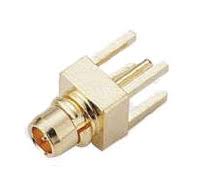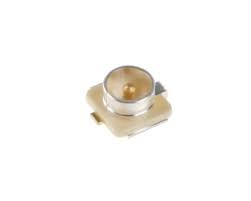The advantage of SDI over LVDS video output can be significant

Key advantages of SDI block cameras over LVDS block cameras
SDI can be directly attached to a frame grabber of e.g. Imperx, allowing you to immediately enter such signals into a PC platform
SDI can have long coaxial cabling (100 meter plus), whereas LVDS is mostly limited by the (fixed) length of the KEL cable (max. 1.5 meters)
Length can further be extended by converting to / using EX-SDI video output.
Easy cabling via direct coax, whereas LVDS requires a converter board or is limited by the KEL cable.
Multiple converters to multiple video signals are present for SDI, whereas LVDS is mostly focused on skoopia on-board video formats.
Larger eco-system (e.g. military, broadcast industry) has created multiple application specific complementing solutions based directly on SDI.
SDI Block Camera implementation
skoopia offers both connectors (U-FL and MMCX on its 21Z/23Z series) allowing more robust plug/unplug connectivity (MMCX) or space savings (U-FL), see image on the left (MMCX left, U-FL on the right).
Block Camera with SDI - smart integration
All skoopia block cameras can have native SDI video output. But there is more.
For SDI output typically the MMCX connector is used. skoopia offers its units with MMCX connector, but also with a U-FL connector.
Why? The U-FL connector allows you to integrate the SDI cabling within the housing of the block camera.
Block camera with U-FL connector

U.FL is a miniature RF connector for high-frequency signals up to 6 GHz. U.FL connectors are commonly used in applications where space is of critical concern, most often Mini PCI cards for laptop computers and WiFi cards.
Total height: 2 mm (paired)
Advantage: cabling can be within housing of the skoopia block camera
Block camera with MMCX connector

MMCX is a small RF connector for high-frequency signals up to 6 GHz. MMCX are commonly used in applications that require more paring or alternate pairing cycles and are standard in near-all cameras having native SDI output.
Total height: 7 mm (paired)
Advantage: multiple pairing of the block camera via MMCX
Block camera with KEL cable & LVDS video output
Although skoopia offers all relevant optical zoom blocks with the physical interface for KEL cable & LVDS video output to meet customer's wanting minimum change, the SDI cabling in combination with 9 pin FFC (Flat Foil Cable) for Power and Rx/Tx (and potential test video signals such as CVBS) proof to be a superior solution for customers looking for rigidity and distance.

skoopia offers a range of block cameras with 10x, 20x, 30x, or super sensitive 36x optical zoom.
All skoopia block cameras can have LVDS output, but we recommend SDI from a cable robustness, cable length capability and back-end integration. And not just for new implementations, but also for projects that require a serious overhaul.
The affordable skoopia block camera series
skoopia's 20Z10S-NF, 20Z10L, 20Z30S and 20Z30L are based on a Panasonic 2 MP sensor (MN series), and offer on board output of:
20Z10S-NF EX-SDI, HD-SDI, 3G-SDI, AHD, CVBS 10x optical zoom
20Z10L EX-SDI, LVDS, CVBS 10x optical zoom
20Z30S EX-SDI, HD-SDI, 3G-SDI, TVI, CVBS 30x optical zoom
20Z30L EX-SDI, LVDS, CVBS 30x optical zoom
As one can see, SDI is always offered as an optional video output, next to LVDS. Key reason: KEL cabling remains cumbersome, cabling is expensive, and in most cases, conversion is required. Where several firms have focused on offering expensive solutions for converting the LVDS to SDI (whcih factually is fairly trivial), skoopia has decided to integrate SDI and LVDS.
The superior skoopia block camera series
skoopia's 21Z10S, 21Z30S and 23Z36S-LL series are based on Sony Starvis Exmor R sensors, and offer parallel video output.
21Z10S HD-SDI, 3G-SDI, LVDS, CVBS 10x optical zoom IMX307
21Z20S HD-SDI, 3G-SDI, LVDS, CVBS 20x optical zoom IMX307
21Z30S HD-SDI, 3G-SDI, LVDS, CVBS 30x optical zoom IMX327
21Z36S-LL HD-SDI, 3G-SDI, LVDS 36x optical zoom IMX385
Also the superior block camera series, SDI is always offered as an option, next to LVDS. But here, LVDS and SDI are offered in parallel mode. SDI could e.g. be directly displayed on a monitor, while the LVDS signal is used for image analysis or "smarter" storage formats such as IP.
SDI block cameras - Easier integration
SDI can be directly attached to a frame grabber of e.g. Imperx, allowing you to immediately enter such signals into a PC platform. Imprex is a potential provider of SDI grabber cards. https://www.imperx.com/frame-grabbers/
Cabling of SDI is straightforward (coax), robust and supports signal transfer over long distance (RG6 - 100 meters HD-SDI / RG6 - 300 meters EX-SDI) - whereas KEL cable based LVDS video transfer is limited to approximately 1 meter.
SDI provides an ecosystem with plural solutions
Multiple converters are available for SDI, each solving a unique -yet subtle - but often mandatory solution for a specific applicatoin environment.
Improve cable length
skoopia offers converters that allow you to take full advantage of the EX-SDI signal format, while maintaining interoperable with all HD-SDI components.
EX-SDI can extend your cable length without amplification, because this visually lossless compression without latency has a lower bandwidth (250 MHz, versus 1500 MHz for HD-SDI).EX-SDI (250 MHz) to HD-SDI (1,5 GHz) conversion allows you to extend the signal and simply add the low cost converter at the end-point to become interoperable with the existing SDI infrastructure. (skoopia converter 15X2-S)
Block cameras and/or other cameras not supporting the EX-SDI signal native, can still make use of this specific format, by converting the regular HD-SDI signal to EX-SDI at the video starting point, while converting it back at the end-point (skoopia converter 15S2X).
A significantly larger eco-system (based on e.g. military, broadcast industry) has created multiple application specific complementing solutions based directly on SDI. From CVBS to SDI converters to SDI wireless solutions are provided by numerous suppliers.
Moreover, tons of converters exist aiming at the medical industry, primarily focused on converting the SDI signal to "consumer electronics" standards such as HDMI (skoopia 30S2-H) or USB (Magewell has a nice 1080p60 converter, https://www.magewell.com/capture/usb-capture)
Sony Block Cameras - Discontinued
Although there were numerous block camera manufacturers, Sony block cameras set the standard, certainly in industrial and medical applications. However, Sony stopped producing their analog block cameras, soon after followed by their announcement to stop with digital HD and Full HD block cameras.
They reintroduced 30x models, first Sony FCB-EV7520A, later the Sony FCB-EV7520, but it is rumoured they will not be in the market for very long.
Sony block cameras interfacing -VISCA & CVBS or VISCA & LVDS
Sony's position in the block camera market was so dominant that near-all alternative suppliers complied -at least to some part- to the standard set by Sony.
Block camera with VISCA
First there is the VISCA protocol, which allows you to control the camera completely from a remote location. It includes query as well as control commands, so you can also request the status of the block camera. VISCA has proven to be suitable for most industrial and medical applications, whereas Pelco-D seems to dominate the security space.
All skoopia block cameras support both Pelco-D and VISCA
Block camera with CVBS
Sony block cameras that had a VGA like resolution comprised a CCD sensor with 0.3 MP (mostly the Red Hat II CCD), offering CVBS output . It is still unclear why so many vendors, Sony included, do not offer native CVBS as output.
All skoopia block cameras have native CVBS onboard to avoid break out boards.
Block camera with LVDS
Sony block cameras that had higher resolutions used Y Pb Pr (early stage) and later LVDS as video output. There are multiple vendors providing converter boards from LVDS to relevant other output formats. TWIGA and VICOS offer LVDS to USB3 converter boards, but also LVDS to CVBS or LVDS to SDI, or LVDS to AHD/TVI.
All optical zoom levels can be sourced from skoopia with on-board video outputs
No need for break out boards. skoopia block camera will include CVBS, AHD, TVI, HD-SDI, 3G-SDI, EX-SDI and/or USB3 video output without break out boards.
skoopia block cameras that replace discontinued Sony Block cameras
10x optical zoom
Sony

analog*
FCB-IX11A / FCB-IX11AP
FCB-EX11 / FCB-EX11P
FCB-EX15 E / FCB-EX14 EP
skoopia alternative 21Z10S, 21Z10L, 20Z10S-NF, 20Z10L
digital
FCB-H11
FCB-EV7100 FCB-EV7130
skoopia alternative 21Z10S, 21Z10L, 20Z10S-NF, 20Z10L
20x optical zoom
Sony skoopia alternative
analog*
FCB-EX45 / FCB-EX47 21Z10S, 21Z10L, 21Z20L, 20Z10S-NF, 20Z20A
FCB-EX2200 / FCB-EX2200P 21Z10S, 21Z10L, 21Z20L, 20Z10S-NF, 20Z20A
FCB-EX480 / FCB-EX480P 21Z10S, 21Z10L, 21Z20L, 20Z10S-NF, 20Z20A
FCB-EX490 / FCB-EX490P 21Z10S, 21Z10L, 21Z20L, 20Z10S-NF, 20Z20A
FCB-EX980 / FCB-EX980P 21Z20L, 20Z20A, 21Z30S, 21Z30L, 20Z30A
digital
FCB-EV5300 /FCB-EV5500 21Z20L
FCB-EV7300 / FCB-EV7320 21Z20L

30x optical zoom Sony
analog*
FCB-EX2700 / FCB-EX2700P
FCB-EX1000 / FCB-EX1000P
FCB-EX1010 / PCB-EX1010P
FCB-EX1020 / FCB-EX1020P
skoopia alternative
20Z20A, 21Z20L, 20Z30A, 21Z30S, 21Z30L
digital skoopia alternative
FCB-EV5500 21Z30S, 21Z30L, 20Z30S, 20Z30L, 23Z36L-LL, 23Z36S-LL
FCB-EV7500 21Z30S, 21Z30L, 20Z30S, 20Z30L, 23Z36L-LL, 23Z36S-LL
FCB-EV7520 21Z30S, 21Z30L, 20Z30S, 20Z30L, 23Z36L-LL, 23Z36S-LL
FCB-EV7520A** 21Z30S, 21Z30L, 20Z30S, 20Z30L, 23Z36L-LL, 23Z36S-LL
** Sony FCB-EV7520A has been introduced. However, this product is inferior to its predecessors (different DSP, incomplete VISCA, lower senstivity sensor).
* skoopia block cameras are based on 2MP sensors. This allows to digitally zoom for at least 2x in CVBS output without resolution loss. A 10x skoopia block camera could be a good replacement for an analog Sony 18x block camera, if only CVBS output is required.
Sony Block Cameras Derivates Listing
The underneath listing of Sony Block Cameras that are EOL and can be replaced by skoopia alternatives is merely added to secure readers that also the derivates of regular cameras (e.g. FCB-EX980, derivatge FCB-EX980S) are also replaceble. Please note that skoopia block cameras are all CMOS based, and can be configured as PAL or NTSC (or 1080p60/30 vs 1080p50/25), whereas all CCD-based Sony Block cameras require a different unit for PAL or NTSC.
Sony block cameras
Analog
NTSC version PAL version
FCB-EX995E FCB-EX995EP
FCB-EX990D FCB-EX990DP
FCB-EX985E FCB-EX985EP
FCB-EX980S FCB-EX980SP
FCB-EX480C FCB-EX480CP
FCB-EX48C FCB-EX48CP
FCB-EX990D FCB-EX990DP
FCB-EX490D FCB-EX490DP
FCB-EX490E FCB-EX490EP
FCB-EX20D FCB-EX20DP
FCB-EX11D FCB-EX11DP
FCB-EX15E FCB-EX15EP
FCB-EX12E FCB-EX12EP
FCB-IX47C FCB-IX47CP
FCB-IX45C FCB-IX45CP
FCB-EX48E FCB-EX48EP
FCB-EX2400 FCB-EX2400P
FCB-EX2200 FCB-EX2200P
Digital
FCB-EH6300
FCB-EH6500
FCB-EH3410
FCB-EH3400
FCB-EH3310
FCB-EH3300
FCB-SE600
FCB-EH3150
List of Sony Block cameras is not complete. Moreover, there are plenty of other vendors that can be replaced with skoopia block cameras, e.g. Hitachi, who also discontinued its block camera program.
Remark: Sony continuous to market 4K block cameras. Here, skoopia has a viable alternative, that has superior low light sensitivity (compared to Sony same size camera) while being significantly more cost-effective. (click here - blog on 4K block cameras).





Comentários